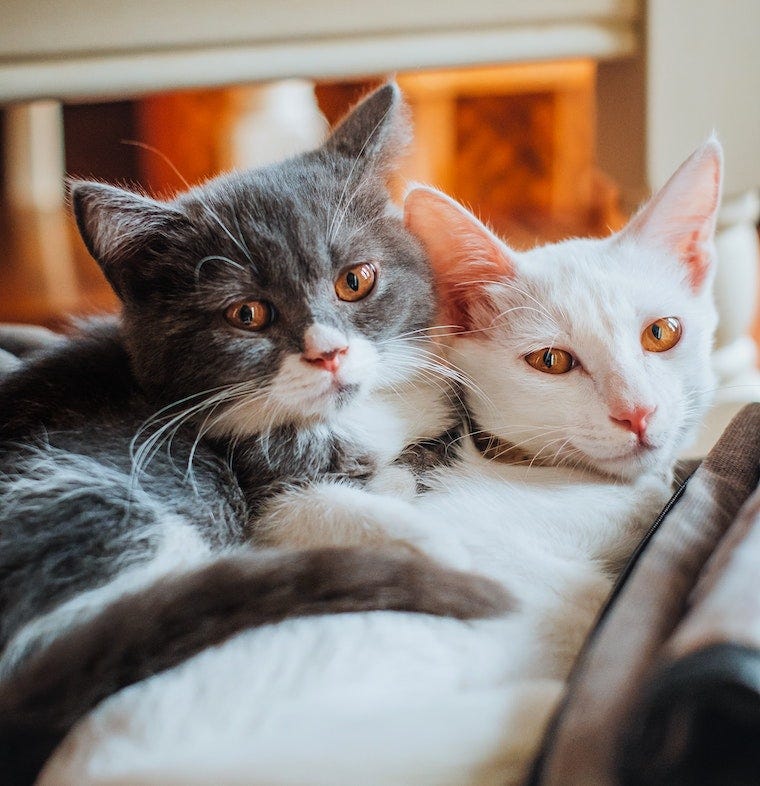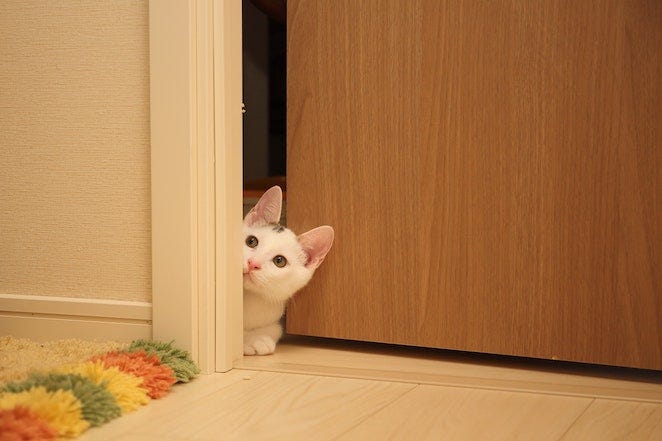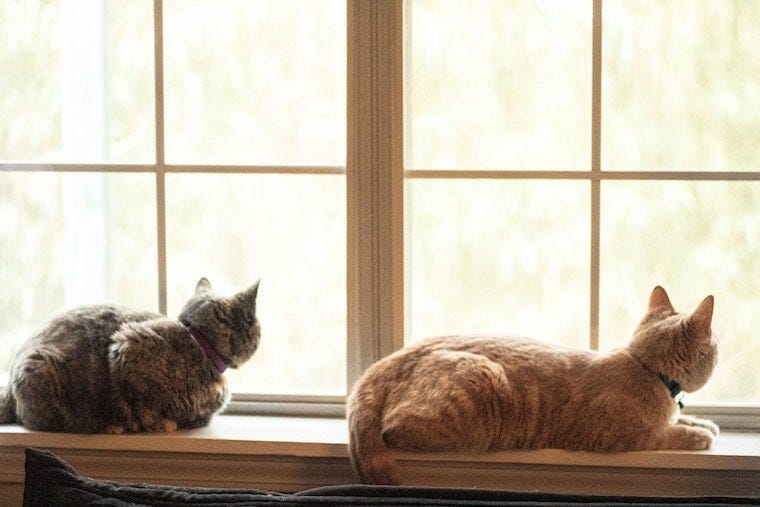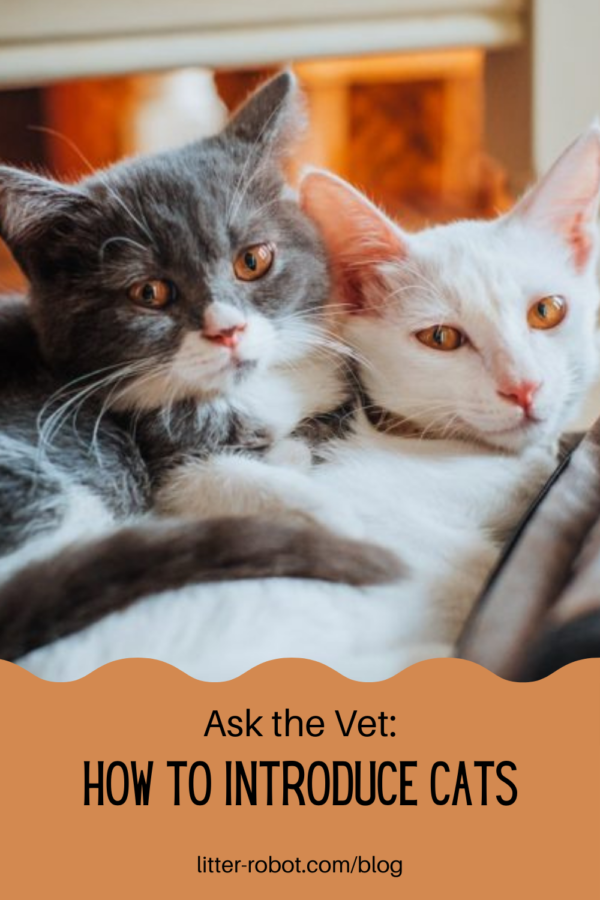As a veterinarian and cat lover, I always prefer to have two cats in my own pet-friendly house. I often find that cats really enjoy the companionship of a feline friend… as long as they get along. That’s why it’s so important to know how to introduce cats! (Keep in mind that veterinary behaviorists and veterinarians often see more medical and behavioral problems when there are more than five cats in a household—so my cutoff is typically 5-6 cats per household.)
Regardless of how many feline family members you have, the most important thing is for ALL your cats to get along. If not, you may find yourself dealing with cat fights, spraying, fighting, and resource guarding (of food bowls, litter boxes, toys, and more).
How To Introduce Cats

Step 1: Go slow.
So, when it comes to introducing new cats to your household, it’s really, really important that you make sure to introduce cats to each other correctly—or you can have a lifelong problem with them not getting along.
My general rule is to go slow. I’m not talking a few days here. I’m talking a few weeks!
The slower, the better when it comes to introducing new cats to each other. It allows everyone to relax and have time to adjust to the new situation.
Step 2: Recognize cat body language.
The second important factor to consider when it comes to how to introduce cats to each other is to observe your cats’ body language. Dog body language is much more obvious. Cat body language? Not so much.
Signs to watch for that mean that your cat is stressed or uncomfortable include the following:
- Flattening of the ears against the head
- Holding the ears to the side
- Dilated pupils
- Holding the tail close to the body
- Not moving
- Laying down
- Growling
- Tail flicking or swishing (“angry cat tail”)
- Looking away
- Moving or “slinking” away
- Holding the whiskers tight to the cheeks
- Holding the whiskers all the way forward
- Running away
- Freezing
- Staring
- Hissing
- Swatting
Step 3: Set the mood.

Now that you know what body language signs to look for in a cat, make sure you “set the mood” when it comes to introducing new cats to each other. Start by creating a rotating safe space for each cat. A little bribery never hurts, either—in moderation. Offer each cat the tastiest treats they’ve ever had (e.g., Churu, tuna, bonito tuna flakes, Temptations).
Home bases
Set up two home bases, such as a separate room with closed doors for each cat, where the other cat can’t go. Each of these should include resting, feeding, water, and litter stations.
Swapping scents
Once you’ve set up your cats in their own space, consider introducing a towel with the other cat’s scent on it. After a day, once they’ve gotten used to it, consider rotating rooms/base stations for 1-2 hours a day. (Don’t let the cats see each other as you move them to their new room.) Swapping the home bases allows the cats to check each other out—chemically, by scent. Be aware that the cats will seem nervous or hesitant at first, as they smell new odors. You may actually notice your cat starting to leave some pheromones around by rubbing their cheeks on things. Your cats are trying to form a community scent, which allows them to identify and form social groupings. Try to rotate a few more times a day or for even longer periods as your cats adjust to this. Hopefully, as your cats become used to the smells, they’ll start to feel more comfortable.
Feliway Multicat
If you notice after a few days to weeks that this isn’t happening, consider pharmacological intervention, too. There are some over-the-counter and prescription-strength medications available from your veterinarian. One of my favorite products is Feliway Multicat. This is a diffuser you can use throughout the house that mimics natural pheromones and has been shown to minimize stress during new cat introductions. This is a MUST for me, as it’s so benign and easy to use—and will help during this stressful time!
Step 4: Let the cats meet.

Okay, so it’s been a few days or weeks. Your cats are used to each other’s smells. Once your cats seem comfortable, allow them to meet through a cracked door or sniff under the bottom of the door. Personally, I usually let my resident cat out of his or her home base, and allow them to sniff under the door of the other cat’s home base. You can also consider swapping and letting the new cat out to sniff under the door if all is going well.
Still going okay? A few days or weeks later, consider using a security guard on the door that allows the door to open but isn’t wide enough for your cat to fit through. Here’s where the bribery is needed! If your cats check each other out on the other side of the door, provide some type of tasty treat if they seem pretty relaxed with this setup. Reward good behavior immediately with snacks if all is going well!
As long as everything is going well, you can gradually open the door an inch or 2 more. Keep in mind that this can take several weeks, but it’s always better to go slowly than to introduce cats too quickly and create lifelong fighting. Remember, when cats are introduced suddenly, it’s an alley cat fight club; and after that, it will be really, really hard to get them to give each other a second chance.
Just like with dating, first impressions are REALLY key for cats—so go slow.
When in doubt, ask your veterinarian for further advice on how to introduce cats. And it’s okay to say yes to drugs! Talk to your veterinarian about prescription anti-anxiety medication—it’s really safe and can help with the process.
If you have tried all of this and the cats still aren’t getting along?
Please consult with a board-certified veterinary behaviorist as soon as possible to help identify and fix the problem. In the case of territorial cats, you may want to explore a self-cleaning litter box for multiple cats.
Before you know it, hopefully all of your cats will be the best of friends!









